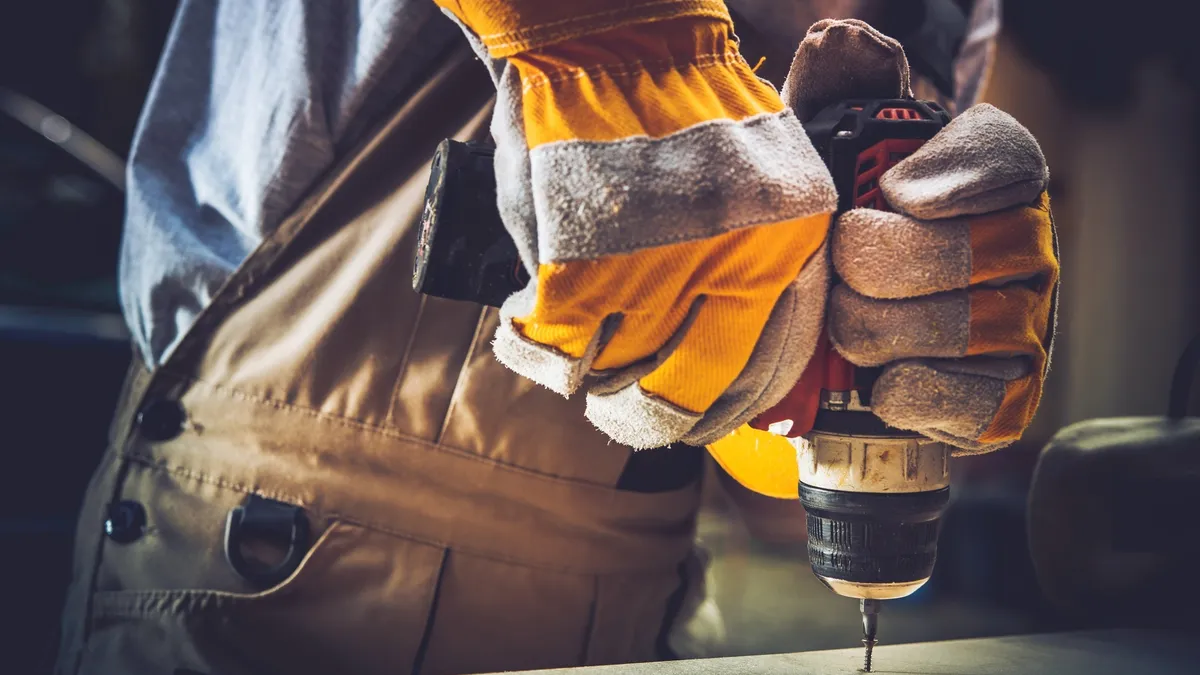Editor's Note: This piece was written by Bill Wilhelm, president of Irvine, California-based R.D. Olson Construction. The opinions represented in this piece are independent of Construction Dive's views.
Job site safety should be the number one priority for any construction company. It’s the right thing to do, it helps improve morale and it keeps construction projects on schedule and under budget.
These four tips can help make your next construction site safer:
Plan ahead
Long before a job starts, extensive planning should be done to identify which tasks will be taking place onsite and how best to plan for potential safety hazards. Project managers and field representatives should put preventative measures in place and communicate them to workers, and provide the appropriate tools and equipment.
Zoning, which involves blocking off areas where certain tasks are taking place, installing catch platforms, nets and other safety measures, is an important part of this planning phase. By allowing only those working on a task within the zoned area past the barrier, it helps to prevent bystander injury. This methodical process also helps ensure that workers within the zoned area have the right protective equipment and tools for that specific job.
One-third of all construction fatalities are a result of falls — from buildings, structural elements and ladders — making them one of the most critical safety issues for which to plan. Appropriate scaffolding needs to be installed, holes in the structure need to be cordoned off or otherwise managed, and other potential fall hazards should be planned for before construction begins.
Transportation incidents are the second most common issue, with vehicle contact/collision accounting for 29% of fatalities.
Manage the risk
Less obvious factors proven to cause safety issues should always be considered when developing and implementing a safety plan. According to a study commissioned by the Associated General Contractors of America (AGC), most deaths on construction sites occur between 10 a.m. and 3 p.m., with fatalities peaking around noon. Almost 75% of fatalities happen on Mondays through Thursdays, with industrial projects reporting more incidents than residential, commercial and other project types. What does this mean for you?
Consider scheduling safety meetings around noon during the beginning of the week, and make sure there is a strong protocol for safety during lunch breaks. If you are working on an industrial site, encourage frequent safety meetings and perhaps more stringent safety protocol that accounts for the dangers unique to industrial building.
The AGC report also shows that small construction companies with one to nine employees account for a much higher fatality rate (26 per 100,000 workers annually) than larger firms. If you are at a smaller company, don’t make safety planning any less of a priority.
There is also a strong correlation between fatalities and the summer months, and deaths are also more common in the South than other areas of the country. This may be due to heat-related illness and exhaustion. Make sure workers have adequate access to water, encourage them to take regular breaks and train them to monitor for heat-related issues.
Scheduling and staffing
Another overlooked but pressing safety issue is worker exhaustion. The industry-wide talent shortage can make it difficult to appropriately staff jobsites, leading some companies to over-schedule workers in order to meet demanding construction schedules. But no matter how many preventative measures and education programs you put in place, it’s all for nothing if workers are too physically or mentally worn out to follow protocol.
The Occupational Safety and Health Administration (OSHA) reports that accidents and injury rates are 30% greater during night shifts, and working 12 hours per day comes with a 37% increased risk of injury. Safety isn’t just a concern on jobsites, though.
Decreased alertness resulting from fatigue has been cited as a contributing factor in major workplace disasters, such as BP's Deepwater Horizon oil refinery explosion, the Challenger space shuttle explosion and the nuclear accidents at Chernobyl and Three Mile Island. Don’t put your construction site at risk for disaster just to shave a few days or weeks off the construction schedule.
Extended shifts can be correlated with an increased risk of having a car accident on the way home from work by 16.2%. They can also lead to a higher probability of developing health problems due to prolonged exposure to chemical and noise hazards.
Companies can help prevent worker exhaustion, and improve retention, by limiting extended shifts, ensuring employees and subcontractors aren’t working too many hours and taking possible talent shortages into account when creating the project schedule.
Safety as a culture
For a safety program to be successful, safety needs to be integral to a company’s culture. Education is one way to instill this. OSHA’s 30-hour Construction Training Course is one example of a valuable program that ensures every worker has the same comprehensive knowledge that can be built upon during company trainings.
While the OSHA program is geared toward safety directors, foremen and field supervisors, it is ideal if everyone in the company goes through the training to make sure the takeaways are spread across every level of the organization. Trainings shouldn’t be relegated only to management and employees. It’s best if subcontractors and other partners also receive trainings, ensuring their safety standards are in line with a GC's own.
Regular safety events, onsite and off, that teach workers about the latest regulations and give refreshers about existing ones are also critical to promoting a culture of safety. They can range from brief onsite recaps to fun team-building exercises. Regardless of the format, they typically should be done at least weekly to make safety part of workers' daily mindsets.
Planning, risk management, staffing and education are all important components of keeping job sites safe. As an industry, we owe it to our workers to prioritize safety and give them all the tools necessary to prevent incidents before they occur.






















